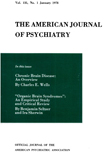FURTHER EXPERIENCES OF THE USE OF MALONONITRILE IN THE TREATMENT OF MENTAL ILLNESSES
Abstract
1. The present paper offers some comments on the preliminary report by MacKinnion, Hoch, Cammer, and Waelsch on the treatment of mental illnesses with malononitrile. The forementioned authors reported 9 cases and stated that they obtained negative results. Their negative results are correlated by the writer to the short duration of the individual treatments.
To this extent, the results of MacKinnon et al. confirm the experience of the writer (Hydén and Hartelius 1948). No therapeutic effects have been observed to follow an m-treatment with a duration of only 15 minutes. In order to obtain results, emphasis is placed here—as in the earlier report (1948)—on the importance of a sufficiently long duration of the individual treatment.
2. The writer also reports on a more recent series of 40 patients with recorded katamneses.
3. Each patient was given an average of 1,250 mg. The average individual dose was 2.4 mg/kg body weight. The average dura-of the m-stage was 48 minutes. The average number of treatments in a course was 8.
4. Table 1 shows the distribution of the cases according to the diagnoses. Endogenous depressions predominate.
5. The mental effect is in the nature of a stimulation that becomes evident within 24-48 hours of each treatment.
6. The results are collocated in Table 2. They are markedly positive in 23 cases, relatively positive in 9, and negative in 8. The results are lasting in 22 cases and transient in 10.
7. The relation between malononitrile treatment and ECT and other forms of therapy is discussed. Twenty-six patients received ECT before malononitrile treatment, with varying results. Contraindications to ECT were present in 23 cases.
8. The clinical value of the method is due mainly to the positive results, its freedom
from risks, and the fact that it is less limited than ECT by contraindications.
Access content
To read the fulltext, please use one of the options below to sign in or purchase access.- Personal login
- Institutional Login
- Sign in via OpenAthens
- Register for access
-
Please login/register if you wish to pair your device and check access availability.
Not a subscriber?
PsychiatryOnline subscription options offer access to the DSM-5 library, books, journals, CME, and patient resources. This all-in-one virtual library provides psychiatrists and mental health professionals with key resources for diagnosis, treatment, research, and professional development.
Need more help? PsychiatryOnline Customer Service may be reached by emailing [email protected] or by calling 800-368-5777 (in the U.S.) or 703-907-7322 (outside the U.S.).



